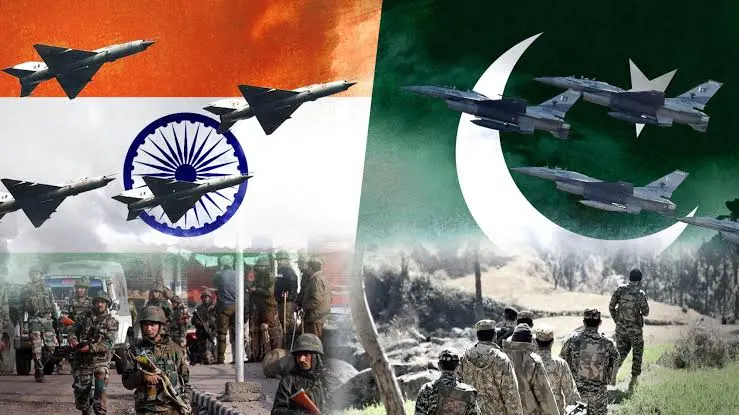
Introduction
The year 2025 saw tensions rise between India and Pakistan, two countries armed with nuclear weapons and locked in a long-standing feud. The PAK-IND Conflict of 2025 came about due to ongoing land disputes, terror attacks across borders, and clashing political interests. This piece takes a close look at what led to this clash, the main events that unfolded how the world responded, and what might happen in the years to come because of this face-off.
Historical Background
The partition of British India in 1947 gave birth to India and Pakistan planting the seeds of the 2025 conflict. These two countries have clashed in several wars—1947 1965 1971, and 1999—over Kashmir. The Line of Control (LoC) drawn after the 1971 war, continues to be a flashpoint often seeing battles and broken ceasefires.
The years before 2025 saw India-Pakistan ties worsen because of:
Terrorist Attacks: India kept accusing Pakistan-based groups (like Lashkar-e-Taiba and Jaish-e-Mohammed) of attacks on its soil.
Diplomatic Deadlock: Peace talks hit a wall, and India scrapped Jammu & Kashmir’s special status in 2019 (by removing Article 370).
Military Growth: Both countries beefed up their armed forces. India zeroed in on fighting terror, while Pakistan boosted its nuclear arsenal.
Causes of the 2025 War
A major terror attack on Indian land sparked the 2025 war. People said Pakistan-based fighters bombed New Delhi killing over 50 civilians. This made the public very angry. India’s leaders felt pushed to blame Pakistan’s Inter-Services Intelligence (ISI) for helping the attackers.
How India Fought Back
Air Attacks on Suspected Terror Bases: India bombed deep into Pakistan-controlled Kashmir hitting what it said were fighter training spots.
Ground Attacks Near the Border: Indian troops moved in to stop fighters from sneaking across.
How Pakistan Hit Back
Said It Wasn’t Involved: Pakistan said India was wrong but promised to strike back for the air raids.
Fought Back: Pakistan’s army fired shells at Indian spots along the border and used drones to attack Indian army bases.
Widespread Escalation
By 2025, the conflict grew larger than the Kashmir region:
- Air Clashes: Indian and Pakistani jets fought near the international border. Each side said they shot down the other’s aircraft.
- Naval Tensions: India stationed its warships in the Arabian Sea. Pakistan responded by intensifying surveillance near Gwadar Port.
- Cyber Attacks: Both countries launched digital strikes aimed at key infrastructure like power systems and communication lines.
Nuclear Threats
The most unsettling change came with their nuclear brinkmanship:
- Senior officials in India raised doubts about the “No First Use” (NFU) policy suggesting the possibility of preemptive action if Pakistan moved its nuclear weapons.
- Pakistan’s top leaders cautioned about their “full-spectrum deterrence” signaling they might deploy tactical nuclear weapons in response to an extensive Indian attack.
Global Responses
Countries around the world acted to stop the situation from escalating into a full-scale war.
- United Nations: The UN Security Council organized emergency talks. They pushed countries to show restraint and asked them to agree to a ceasefire.
- United States: The U.S. worked behind closed doors. It put pressure on both sides to calm the conflict.
- China: Pakistan’s ally China encouraged talks but warned against “external interference,” hinting at Western nations.
- Russia: Russia offered its help to mediate and highlighted the danger of nuclear tensions.
- OIC & Arab World: The Organization of Islamic Cooperation shared its worries about Kashmir but stopped short of condemning India .
Ceasefire and What Followed
After weeks of heavy combat, the two nations accepted a ceasefire arranged by the UN. The main results were:
- Humanitarian Disaster: Thousands of people lost their homes, and allegations of war crimes surfaced.
- Economic Collapse: Stock markets plunged, and trade, which was already scarce, stopped .
- Diplomatic Setbacks: Western countries imposed sanctions on both nations, which hurt their economies.
Possible Long-Term Effects
- Regional Instability: The fighting increased tension reducing chances of future peace discussions.
- Arms Race: Both countries boosted their missile and nuclear development efforts.
- Global Geopolitics: The U.S. and China took the crisis as a chance to expand their power. Washington stood with India, while Beijing aligned with Pakistan.
- Kashmir’s Status: The area stayed split, and no political solution appeared to be near.
Conclusion
The PAK-IND Conflict of 2025 highlighted how old disputes and current politics can drive two nuclear-armed neighbors close to war. They avoided a full war, but the core issues remain keeping South Asia unstable. Nations around the world need to work on ways to resolve such conflicts to stop future escalations from turning disastrous.